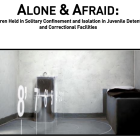
The JJIE Interview: Bart Lubow, the Man Behind JDAI
|
More than two decades ago, when the Annie E. Casey Foundation began its groundbreaking Juvenile Detention Alternatives Initiative (JDAI), the notion that the juvenile justice system could and should reduce its reliance on detention was nothing short of revolutionary. Bart Lubow, director of the Juvenile Justice Strategy Group at Casey, designed and managed JDAI, which began in 1992. Lubow is retiring as of June 30, but he will continue to work with the foundation as a consultant and says he plans to do a lot of writing and speaking. JJIE asked Lubow, 66, to talk about his tenure and legacy at Casey, particularly JDAI, the nation’s most widely replicated juvenile reform effort, now operating at more than 250 sites in 39 states and the District of Columbia. Edited excerpts of the interview follow.








